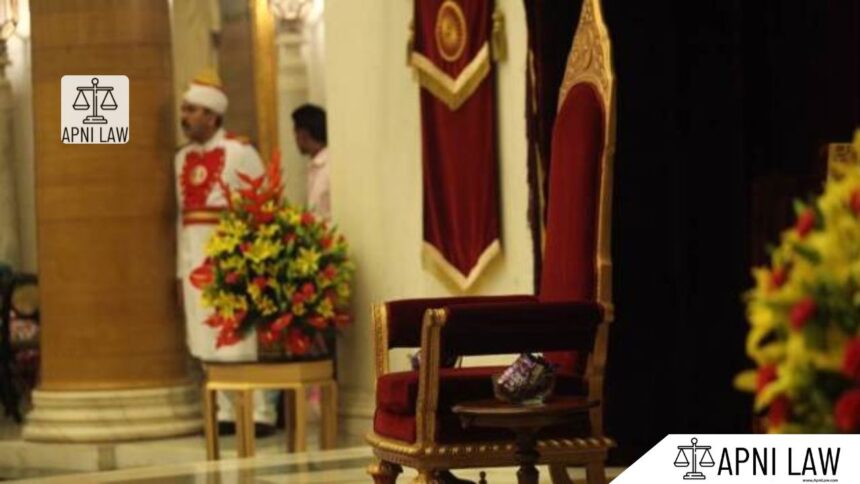The Indian Constitution establishes a careful balance between the legislature and the executive. While Parliament has the primary responsibility of law-making, the President also plays a significant role in the legislative process. Under Article 111, the President exercises what is known as the veto power over bills passed by Parliament.
This power is not ornamental. It enables the President to withhold assent to a bill, return it for reconsideration, or keep it pending without decision. In simple terms, the President can either accept a bill, reject it, or delay action. The Constitution recognizes three main types of vetoes, absolute veto, suspensive veto, and pocket veto. Each operates in different circumstances and serves as a check against hasty, unconstitutional, or poorly drafted legislation.
What Is the Veto Power Under Article 111?
Article 111 states that when a bill is passed by Parliament, it is presented to the President. The President can either give assent, withhold assent, or return the bill for reconsideration if it is not a money bill. If the bill is returned and passed again by Parliament, the President must then give assent.
This arrangement shows that the President is not a passive figure. The veto power ensures that the executive has a role in preventing unconstitutional or undesirable laws. It also provides a second opportunity for Parliament to reflect on its decisions.
What Is the Absolute Veto?
Absolute veto means the President refuses to give assent to a bill, and the bill lapses. Once rejected in this manner, the bill is dead and cannot be revived. This veto is final and absolute.
In practice, the President uses this veto rarely. It usually applies to private members’ bills or to government bills where the recommending Cabinet has resigned or lost majority. In such cases, the bill loses political legitimacy, and the President has the right to terminate it completely.
For example, President Neelam Sanjiva Reddy used the absolute veto in 1979 when he refused assent to the Salary, Allowances and Pension of Members of Parliament (Amendment) Bill. The government which introduced the bill had resigned, and the new government advised the President not to give assent. This illustrates how the veto works as a safeguard in political transitions.
What Is the Suspensive Veto?
Suspensive veto comes into play when the President returns a non-money bill to Parliament for reconsideration. The veto is called suspensive because the President’s refusal is temporary. If Parliament passes the bill again, with or without amendments, the President must give assent.
This veto cannot apply to money bills. Article 110 makes it clear that money bills are the exclusive domain of the Lok Sabha, and once passed, the President must assent to them.
Suspensive veto reflects a middle ground. It gives Parliament a chance to rethink but also respects its supremacy if it reaffirms the bill. It acts as a constitutional dialogue between the executive and legislature. For instance, President A.P.J. Abdul Kalam once considered using this veto on the Office of Profit Bill, 2006, but later gave assent after reconsideration.
What Is the Pocket Veto?
Pocket veto occurs when the President neither assents nor rejects nor returns the bill. The Constitution does not fix a time limit for presidential action. As a result, the bill remains pending indefinitely. This unique feature distinguishes India from countries like the United States, where the President must act within a fixed time period.
Pocket veto is rare but significant. President Zail Singh famously used it in 1986 by withholding action on the Post Office (Amendment) Bill, which sought to give government wide powers to intercept mail. He kept the bill pending in his pocket without rejecting it. By doing so, he avoided direct confrontation with Parliament but effectively stalled the law.
This veto demonstrates how the President can act silently yet decisively to prevent controversial legislation.
Can the President Use Veto on Constitutional Amendment Bills?
The veto power does not extend to constitutional amendment bills. Under Article 368, once such a bill is passed by a special majority in Parliament and ratified by states (if required), the President must give assent. There is no discretion here. This ensures that amendments to the Constitution reflect the will of Parliament and the states, without executive interference.
Why Is the Veto Power Important?
The veto power is not intended to weaken Parliament but to ensure balanced law-making. It acts as a constitutional check on legislative overreach. Parliament may sometimes pass bills in haste, under political pressure, or without sufficient deliberation. The President’s veto provides an additional layer of scrutiny.
By using veto powers, the President ensures that bills conform to the Constitution, respect fundamental rights, and align with national interest. It also promotes cooperation between the executive and the legislature.
How Rarely Is Veto Power Used?
Although veto powers exist, their use is rare. Most bills presented to the President receive assent. This is because the President acts on the advice of the Council of Ministers under Article 74, and ordinarily, the Cabinet ensures that bills are constitutionally valid.
However, the few cases where veto powers were exercised demonstrate their importance. They show that the President is not just a ceremonial head but a constitutional guardian.
How Does the Indian Veto Compare With the American System?
The Indian veto system differs significantly from that of the United States. In the US, the President has a qualified veto. If the President returns a bill, Congress can override the veto with a two-thirds majority. The US President must act within ten days, either signing or rejecting the bill.
In India, the President’s veto is broader in some respects. The pocket veto allows indefinite delay, which does not exist in the US. At the same time, India limits veto powers on money bills and constitutional amendments, emphasizing parliamentary supremacy.
What Are the Criticisms of Veto Power?
Critics argue that veto powers may delay necessary reforms. If used excessively, they can paralyze the legislative process. Some believe the pocket veto lacks transparency since bills can remain pending without explanation. Others feel the power is largely symbolic, as the President normally acts on Cabinet advice.
Yet, supporters emphasize that even symbolic powers matter. The very existence of veto powers ensures that Parliament drafts laws more carefully. It prevents unconstitutional or politically motivated legislation from slipping through unchecked.
What Are the Constitutional and Political Implications?
The veto powers highlight the spirit of checks and balances in Indian democracy. They underline that Parliament is supreme in law-making but not beyond constitutional limits. The executive, through the President, retains a modest but meaningful role in legislative review.
Politically, veto powers may become significant during unstable governments, coalition eras, or when controversial bills create public unrest. In such times, the President’s decision can influence the course of legislation and even protect democratic values.
For any specific query call at +91 – 8569843472
Conclusion
The veto powers of the President, absolute, suspensive, and pocket, form an essential part of India’s constitutional framework. They give the executive a role in law-making without undermining the supremacy of Parliament. Though rarely used, these powers act as safety valves, ensuring laws meet constitutional standards and democratic principles.
The absolute veto kills a bill outright, the suspensive veto allows reconsideration, and the pocket veto delays action indefinitely. Together, they create a nuanced system of legislative control. While misuse could disrupt governance, wise use strengthens democracy.
In essence, the veto powers symbolize the President’s role as the guardian of the Constitution. They remind Parliament that while it represents the will of the people, its laws must always remain within the framework of constitutional propriety.







